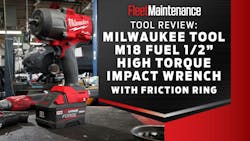Tool review: M18 FUEL 1/2" High Torque Impact Wrench with Friction Ring
Milwaukee Tool calls its M18 FUEL 1/2" High Torque Impact Wrench with Friction Ring, which uses the company's Powerstate brushless motor, "the most power-dense impact wrench in its class," which is the mid-range category. The sturdy 7.6" x 9.35" tool delivers 1,100 lb.-ft. of fastening torque and 1,500 lb.-ft. of nut-busting torque when used with the 18V REDLITHIUM XC5.0, and pairing it with the M18 REDLITHIUM FORGE batteries provide a bit of a boost at 1,200 lb.-ft. of fastening torque and 1,600 lb.-ft. of nut-busting torque.
The 1/2" friction ring anvil also enables seamless socket changes to get the job done quicker, according to Milwaukee.
To find out how it fares in the shop, we handed the M18 to Collin Battles, an expert technician at Toyota Cleveland Heights in Ohio. Milwaukee provided the M18 set, No. 2967-22, which comes with two XC5.0 batteries and a charger, along with the Shockwave 1/2" drive socket set. The tech used the M18 for about a month prior to providing feedback.
Battles called the M18 Fuel 1/2" "probably the most power for the price point." He pointed to the tri-LED lighting around the anvil as highly useful for illuminating hard-to-see areas, and the four control modes as highly effective for providing the right amount of torque and preventing fasteners from being over-tightened.
One of the first things he noticed is that the stout design shaved 2" off the length, allowing for easier access into wheel wells. "You can pretty much take it where you want," Battles said.
The footprint, along with the lengthy operating time provided by the XC5.0 battery, has made Battles a believer in cordless impact wrenches. “The first time I used it, [the battery] lasted me a week,” he said, “And the charge time is not long at all.”
The veteran automotive technician "used to use pneumatic for everything, but the M18 is more mobile… You don't need 20 feet of hose to get somewhere, you can just go anywhere in the shop and not have to worry about it.”
He used this M18 Fuel model for removing and refastening lugnuts, control arms, and shields.
When asked what he would change about the tool, Battles mentioned that “the weight is a little heavy for the gun and you could improve maybe a half pound.” Although the M18 is a powerful tool, Battles remarked that he doesn’t need that much power for his work on passenger vehicles and light trucks. While “it's very nice to have it, I would almost want it to be lighter and a little less power, and I think it would be a perfect impact gun,” he said. He added for heavy-duty applications, that power would come in handy.
All in all, Battles was happy with the performance and said, “I would definitely recommend it.”
About the Author

Lucas Roberto
Lucas Roberto is an Associate Editor for Fleet Maintenance magazine. He has written and produced multimedia content over the past few years and is a newcomer to the commercial vehicle industry. He holds a bachelor's in media production and a master's in communication from High Point University in North Carolina.
